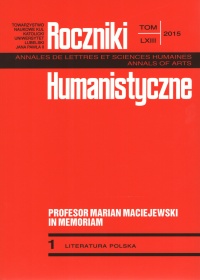Kerygmatic Method Versus Epistolography − Recognition
Abstract
The text is an attempt at an answer to the questions: Is the kerygmatic method (or: can it be) a tool for studying epistolography that is a branch of writing, to which it is closer than to literature? Was Prof. Maciejewski right when he thought that each and every work will betray its status of being situated in God's Word when it is forced to give answers to questions arising out of the apostolic kerygma, and is such a coercion possible when researching epistolography? The article justifies the thesis that this is possible, albeit one has to consider some limitations here. Firstly, epistolography may be a kerygma, but it is quite an elite testimony: there is one sender and only one addressee, usually selected by the sender. Only in the case of letters published in print the kerygma has a more powerful influence. Secondly, a reflection on the kerygma of epistolography has to be limited to letters that have a confessional character, letters-confessions, and it has to eliminate the ones that are characterized by primary utilitarianism.
The author has made a collection of letters by Zygmunt Szczęsny Feliński entitled “A Saint's Letters to His Mother” the subject of her reflection. An analysis of them has allowed her to notice the presence of the kerygma understood as the first preaching that produces faith. Hence Szczęsny's letters may be interpreted as letters written by an apostle, by a witness, but also by a man who reveals his wisdom; wisdom that brought him to sainthood. The sender “coerces” the readers-recipients to open themselves to Christ, testifying about the efficiency of this way with his sainthood. This “coercion” is a peculiar sort of pedagogy, a proposal to enter the road that has become the road to sainthood. So it seems that when studying epistolary documents one may use the kerygmatic method of interpretation - certainly with the reservations mentioned at the beginning. Then one may, perhaps not better, but surely, understand their message more deeply.
References
Feliński Z.Sz., Listy Świętego do Matki Ewy z Wendorffów Felińskiej z lat 1838-1860, oprac. T.A. Frącek, Warszawa 2012.
Feliński Z.Sz., Paulina córka Ewy Felińskiej, Lwów 1885.
Maciejewski M., Literatura w świetle kerygmatu, [w:] tenże, „ażeby ciało powróciło w słowo”. Próba kerygmatycznej interpretacji literatury, Lublin 1991.
Skwarczyńska S., Teoria listu, oprac. E. Feliksiak, M. Leś, Białystok 2006.
Sudolski Z., Korespondencja, [w:] Słownik literatury polskiej XIX wieku, red. J. Bachórz, A. Kowalczykowa, Wrocław 1991.
Śliwowska W., Zesłańcy polscy w Imperium Rosyjskim w pierwszej połowie XIX wieku. Słownik biograficzny, Warszawa 1998.
Trzynadlowski J., Małe formy literackie, Wrocław 1997.
Turkowski T., Ewa Felińska, [w:] Polski słownik biograficzny, t. VI, red. W. Konopczyński, Kraków 1948.
Copyright (c) 2015 Roczniki Humanistyczne

This work is licensed under a Creative Commons Attribution-NonCommercial-NoDerivatives 4.0 International License.





